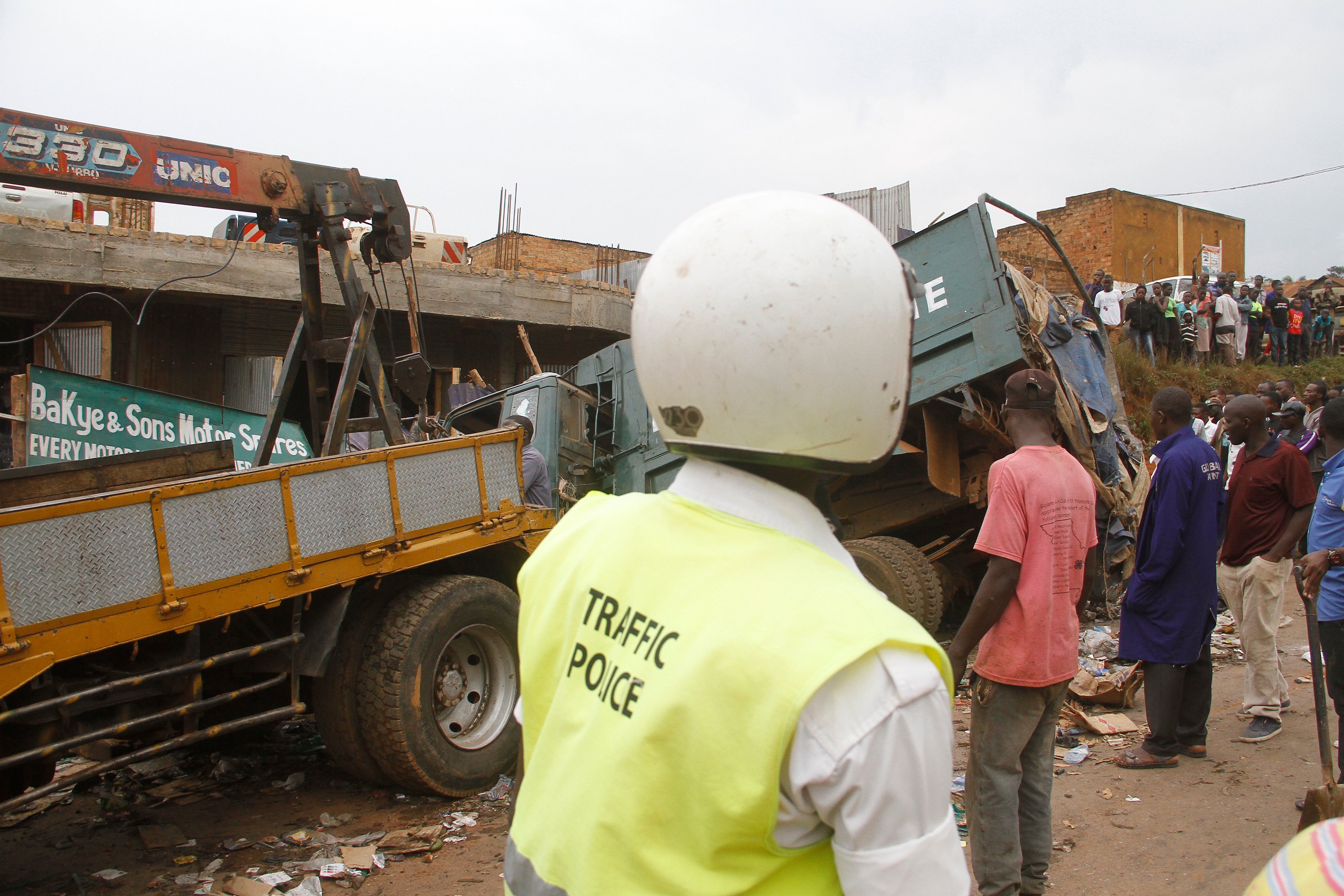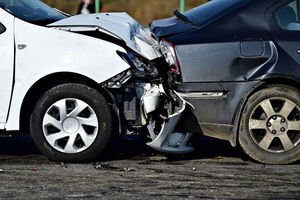
The wreckage of a truck that crashed into a classroom block, killing four students and injuring 20 others at Kasaka Secondary School in Kanoni Town Council, Gomba District on March 14, 2023. PHOTO/ BRIAN ADAMS KESIIME
Motor third-party insurance, which covers injury, death, or accident-related losses, is a policy that is falling out of favour with the public, with its decline affecting both insurers and the vulnerable left unprotected when accidents occur.
This publication understands that most clients are abandoning these policies, frustrated by delayed claim settlements and another battle of the computation of their supposed to be benefits, which are currently deemed so low. This leaves them exposed to risks that they sought to hedge themselves against in the first place.
Motor third-party insurance is mandatory for all vehicle owners, including two-wheelers, but it only covers death and physical harm to roadside victims, excluding damage to the vehicle, rider, or driver under the current law.
According to the current compensation caps, victims are entitled to Shs1 million if they are many. However, in cases where there are few victims, the amount may reach Shs10 million. In addition to these intricacies, delays in claim payments have led to unregulated schemes mimicking insurance models in communities outside the Insurance Regulatory Authority (IRA)'s oversight. Mr Ibrahim Lubega Kaddunabbi, the IRA chief executive, highlighted the need to increase compensation limits.
“We want to change the law so accident victims don’t need to prove fault before getting paid,” he said.
Flaws
Current caps stand at Shs1 million, an amount seen as too low for the damage accidents cause. Regulator data shows an increase in claims paid, but delayed payouts—often due to case complexity—continue to frustrate clients. In 2023, insurers paid Shs820.47 billion, up from Shs618.71 billion in 2022 and Shs564.82 billion in 2021. In 2023, local insurers paid out Shs820.47 billion, up from Shs618.71 billion in 2022 and Shs564.82 billion in 2021.
After an accident, insurers send assessors to evaluate damage, with the insured sometimes bringing in their own assessor to challenge the findings and agree on compensation. And while the regulator has made efforts to address this issue, no significant results have been achieved so far.
During complaints meetings and hearings, Sunday Monitor understands that “the Bureau usually observes inconsistencies in information submitted and oral evidence given, which has necessitated referral of the complaints suspected of fraud to the Insurance Anti-Fraud Unit for further investigations.”
There have also been instances where poorly assessed claims and bias by the loss assessors has manifested.
“Assessors do not carry out thorough investigations when assessing claims; others are not independent and professional whilst handling these assessments. As a result, the Bureau is always constrained to rely on poor quality or biased reports, which has led to delay in resolution of complaints because the Bureau has to appoint another independent assessor to carry out fresh investigations. The average period it usually takes to conclude the investigations and the report is three months,” IRA said in its 2022 annual report.
Plugging the gaps
Mr Kaddunabbi said the authority has drafted a law aimed at fixing loopholes in motor third-party insurance, including raising the Sh1 million claim limit and removing the current prerequisite of proving who was in the wrong for the accident to happen before victims are compensated.
“The drivers and the conductors are not covered by motor-third party insurance under the current law. We want to address all these issues in a new law so that the money for compensation increases from Shs1 million to at least Shs10 million,” he told Sunday Monitor, adding that this will be a relief for the insured who usually have to part with Shs100,000 to gain access to a police report to prove absolution.
Other documentation required involves letters of administration in case one loses a relative in a crash and is the one seeking the claim, something that can also be costly to get.
“We are trying to address all that in the new law, but we have not yet succeeded. We want to change the limits of the money involved and also make sure that if people have been involved in an accident, you do not need to prove who was in the wrong because that’s what the existing law requires in order for you to be paid,” Mr Kaddunabbi said at a media engagement workshop in Kampala this past week.
“So the law we drafted also protects the driver, protects the conductor and many other things but we are still hoping to see that we can have that law through to Parliament,” he added.
In 2015, with World Bank support, the IRA drafted a new Bill to reform the insurance sector and address most of these aforementioned concerns. It was sent to the Finance ministry for review, but progress stalled, delaying enforcement.
Road accidents
New data from the Health ministry shows that road traffic injuries are the fifth leading cause of death in hospitals, with 45 percent of emergency admissions in casualty units at referral hospitals being traffic-related.
Mulago National Referral Hospital reported that 400 road trauma patients were admitted to ICUs in the 2021/2022 period, 83 percent of whom were male. The cost of treating road traffic injury victims who do not require surgery is approximately Shs3.9 million per patient. For those who need surgery, the cost rises to Shs13.6 million per patient.
Doctors sounded out by this publication said the average hospital stay is about two days. For single organ injuries, the stay ranges from one to two weeks. Patients with severe injuries might stay for up to four weeks, and those with critical conditions, especially those with severe brain injuries and needing intensive care, may occupy anywhere between one to three months.
Meanwhile, the kind of insurance that’s supposed to reduce this glaring damage is really low among the populace. A large number of vehicles are uninsured despite the growth in total premiums. Yet the financial impact of non-compliance is substantial, with considerable losses to both the government and the insurers.
A Health ministry dataset shows that in 80 percent of orthopaedic wards at referral hospitals nationwide that year, traffic-related injuries accounted for 45 percent of patients visiting casualty units. Some of the survivors have had to deal with tremendous trauma.
Depending on the hospital in question, each victim pays Shs3.9 million for non-surgical treatment, and Shs13.6 million for surgical intervention. And victims stay for days at hospitals trying to treat these traumas and injuries from road crashes.
Fraud in insurance
An insurance policy that would have helped them survive this situation is the motor third party, but it remains unpopular among the populace. The data from the IRA shows that only 700,000 vehicles are currently insured out of the estimated 1.8 million motor vehicles in Uganda.
The average monthly insurance premium, including Value Added Tax (VAT) but excluding Stamp Duty, is approximately Shs41,000; the average premium, after deducting 18 percent VAT, is, therefore, approximately Shs34,746 for each policy.
The regulator projects that non-compliance costs the government a figure of around Shs42.3 billion directly, of which Shs39.26 billion comes from Stamp Duty, and costs the insurance industry Shs39b.
A quote from the regulator on how the vice is distorting the insurance business reads: “Fraud remains a big challenge in the insurance sector since fraudsters have now become more sophisticated in covering their fraud neatly so that it is not easily detected.”
At times, it has even necessitated referral of the complaints suspected of fraud to the Insurance Anti-Fraud Unit for further investigations.
Parliament records show that a significant portion—nearly 80 percent—of the Comesa Yellow Card stickers are forged. This means many vehicles on the road with these stickers are not genuinely insured. As a result, victims of road accidents involving these vehicles may find that there is no valid insurance to cover their claims.
The Comesa Yellow Card is a motor vehicle insurance scheme that provides third-party liability coverage for motorists travelling across multiple countries within the Common Market for Eastern and Southern Africa (Comesa) region. It is designed to facilitate the smooth movement of vehicles across borders by ensuring motorists have adequate insurance coverage in case of accidents or incidents involving third parties.
Due to this widespread forgery, many victims of road crashes are left without the financial protection that third-party insurance is supposed to provide. If a victim is involved in an accident with a vehicle that has a forged insurance sticker, they may not receive compensation for damages or injuries.
The integration of the automated licensing system from the Works and Transport ministry with the IRA system might have brought these issues to light. However, the existing problems with fraud and claim denials remain a significant challenge.
Without swift reform, the motor insurance sector risks leaving more Ugandans vulnerable on the road—both drivers and pedestrians.



